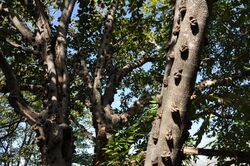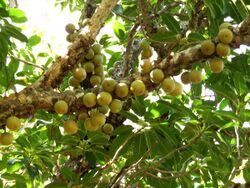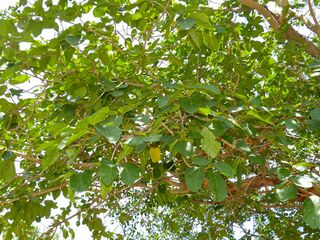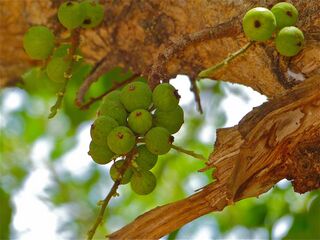Biology:Ficus sansibarica
| Knobbly fig | |
|---|---|

| |

| |
| The nominate subsp. in the Kruger Park | |
| Scientific classification | |
| Kingdom: | Plantae |
| Clade: | Tracheophytes |
| Clade: | Angiosperms |
| Clade: | Eudicots |
| Clade: | Rosids |
| Order: | Rosales |
| Family: | Moraceae |
| Genus: | Ficus |
| Species: | F. sansibarica
|
| Binomial name | |
| Ficus sansibarica Warb. 1894
| |
| Synonyms[2] | |
| |
The Ficus sansibarica, known as knobbly fig, is an African species of cauliflorous fig. It is named after Zanzibar, where Franz Stuhlmann discovered it in 1889.[3] They often begin life as epiphytes, which assume a strangling habit as they develop.[4] They regularly reach 10 m, but may grow up to 40 m tall as forest stranglers.[1]
Range and habitat
It occurs in the African tropics and subtropics from coastal elevations to 900 m above sea level.[5] The nominate subspecies has an easterly distribution, but extends westwards up the Zambezi Valley.[6]
They are found in coastal, riverine and evergreen forests or woodland, and in miombo woodlands. They are locally cultivated in parks,[6] villages[4] or bush camps. They prefer deep sandy soil and often start life as a strangler.[7][8] The pollinating wasp is Courtella armata.[5]
Description
The light grey bark is fairly smooth, though lumpy and folded.[1] The smooth leaves are up to 13 cm long and oblong-obovate.[8] They have parallel sides and are carried on slender petioles.[1]
The large (up to 5 cm), bitter-tasting figs appear in groups of 2 or 3 during the summer months.[1] They are cauliflorous, growing on the characteristic wart-like, leafless branchlets on the trunk and main branches (i.e. old wood).[7]
F. chirindensis of the forests of southeastern Zimbabwe and adjacent Mozambique is similar, but has the leaves more oval, often has buttress roots,[7] and bears the small (1.5 cm) figs in stalked pairs on second year branches.[1]
Uses
The raw figs are used for food, and are locally believed to promote fertility. Stems are torn apart to obtain fibers for basket weaving.[4] Locally it is also deemed sacred.
Subspecies and status
- F. s. subsp. sansibarica – East Africa: southern Kenya, Tanzania, Malawi, Zambia, northern Botswana, Zimbabwe, Mozambique, northeastern South Africa and Eswatini
- F. s. subsp. macrosperma (Warb. ex Mildbr. & Burret) C.C.Berg – West and Central Africa: Senegal to DRC, Uganda and Angola
The species is deemed critically endangered in Eswatini, where most are located in proposed sugar cane expansion areas near Sihoye.[9] On Inhaca Island however, it is held sacred by most communities, and is scrupulously protected.[3]
Gallery
-
Foliage
-
Figs on wart-like branchlets
-
Figs carried on spurs
References
- ↑ 1.0 1.1 1.2 1.3 1.4 1.5 Palgrave, K.C. (1984). Trees of Southern Africa. Cape Town: Struik. pp. 114–115. ISBN 0-86977-081-0.
- ↑ "Ficus sansibarica Warb.". The Plant List. 2010. http://www.theplantlist.org/tpl/record/kew-2812180. Retrieved 5 July 2013.
- ↑ 3.0 3.1 Mtsweni, Patrick. "Ficus sansibarica Warb.". PlantZAfrica.com. SANBI. http://www.plantzafrica.com/plantefg/ficussansi.htm. Retrieved 24 July 2013.
- ↑ 4.0 4.1 4.2 Fern, Ken (2019). "Ficus sansibarica Warb. Moraceae". tropical.theferns.info. http://tropical.theferns.info/viewtropical.php?id=Ficus+sansibarica. Retrieved 31 May 2019.
- ↑ 5.0 5.1 Van Noort. "Ficus sansibarica sansibarica Warburg 1894". Figweb. iziko museums. Archived from the original on 30 November 2012. https://web.archive.org/web/20121130033842/http://www.figweb.org/Ficus/Subgenus_Urostigma/Section_Galoglychia/Subsection_Caulocarpae/Ficus_sansibarica_sansibarica.htm. Retrieved 7 January 2012.
- ↑ 6.0 6.1 Berg, C. C. (1991). "Ficus sansibarica subsp. sansibarica [family MORACEAE"]. Flora Zambesiaca (JSTOR Global Plants) 9 (6): 13. https://plants.jstor.org/stable/10.5555/al.ap.flora.fz92. Retrieved 31 May 2019.
- ↑ 7.0 7.1 7.2 Van Wyk, Braam (1997). Field Guide to the Trees of Southern Africa. Cape Town: Struik. p. 78. ISBN 1-86825-922-6.
- ↑ 8.0 8.1 Palmer, Eve (1977). A Field Guide to the Trees of Southern Africa. London, Johannesburg: Collins. pp. 89–90. ISBN 0-620-05468-9.
- ↑ "SABONET Report No. 38". Moraceae. p. 119. Archived from the original on 12 August 2011. https://web.archive.org/web/20110812205130/http://www.sabonet.org.za/downloads/35_swaziland_tree_atlas/f.swazi.ficus-rosaceae.pdf. Retrieved 7 July 2013.
External links
Wikidata ☰ Q15476842 entry
 |




